Entrepreneurship and Small Business Management
VerifiedAdded on 2023/01/12
|13
|4626
|92
AI Summary
This document discusses various types of entrepreneurial ventures, their similarities and dissimilarities, and the impact of micro and small businesses on the economy. It also explores the importance of small and start-up businesses in the growth of the social economy.
Contribute Materials
Your contribution can guide someone’s learning journey. Share your
documents today.
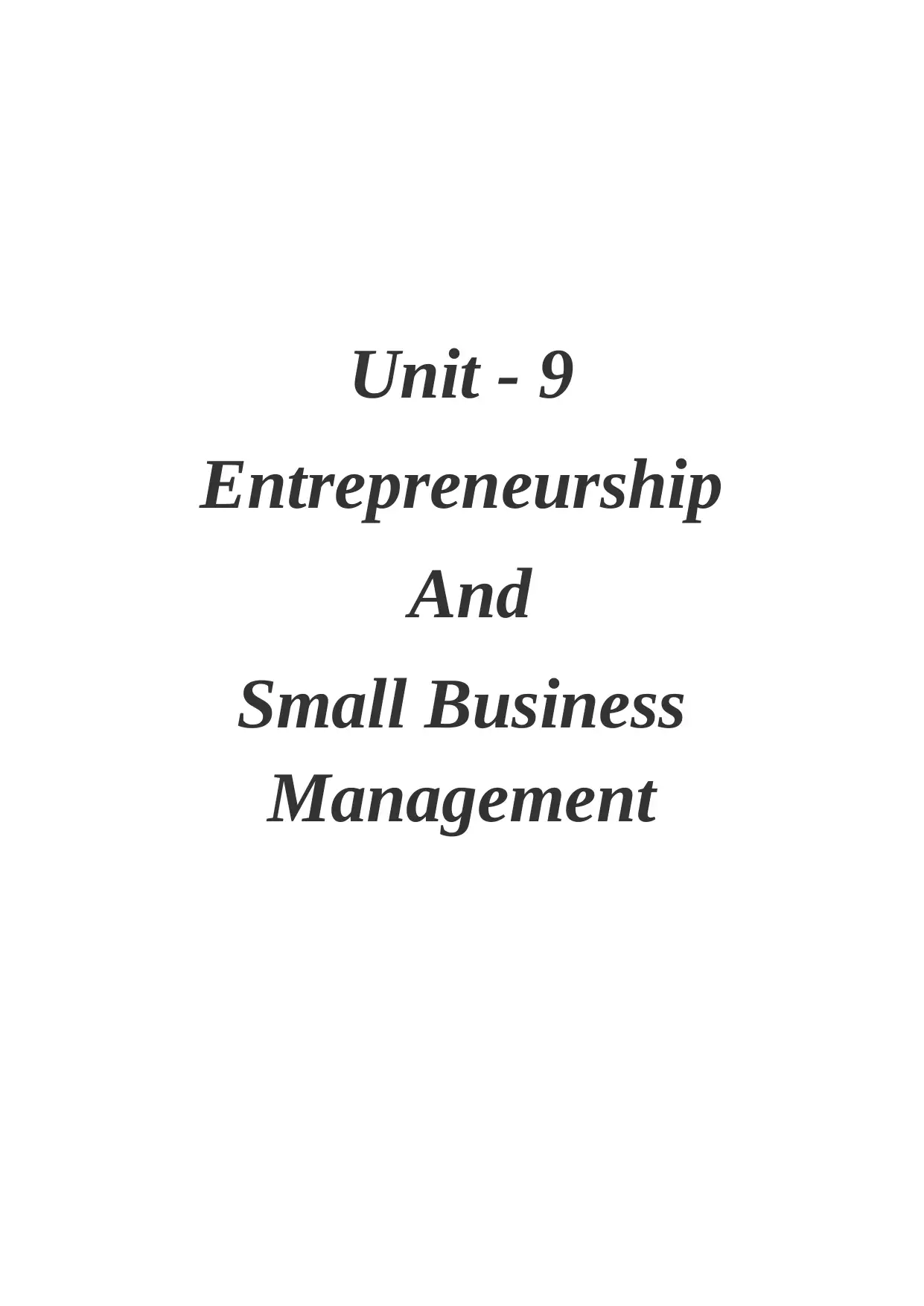
Unit - 9
Entrepreneurship
And
Small Business
Management
Entrepreneurship
And
Small Business
Management
Secure Best Marks with AI Grader
Need help grading? Try our AI Grader for instant feedback on your assignments.
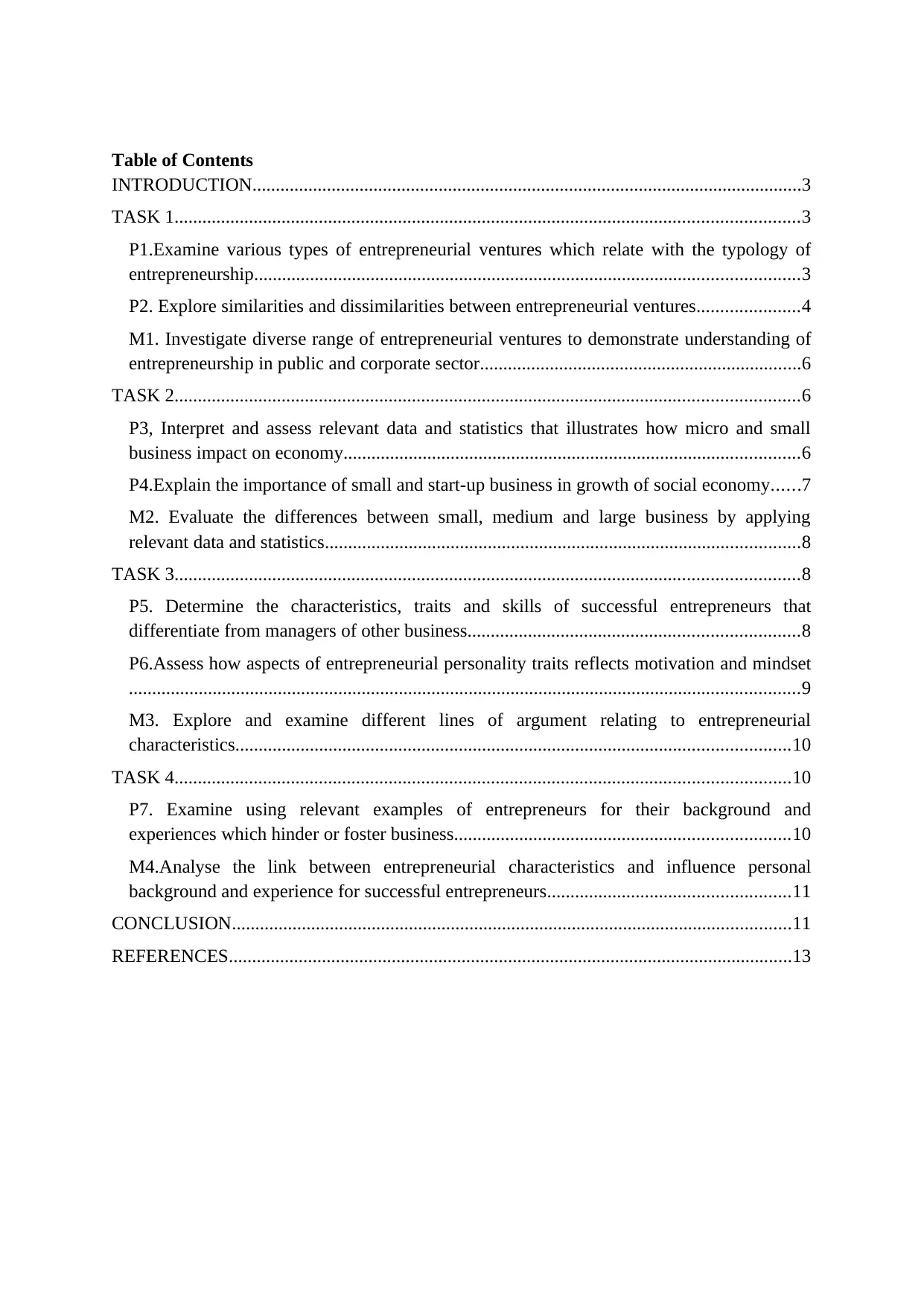
Table of Contents
INTRODUCTION......................................................................................................................3
TASK 1......................................................................................................................................3
P1.Examine various types of entrepreneurial ventures which relate with the typology of
entrepreneurship.....................................................................................................................3
P2. Explore similarities and dissimilarities between entrepreneurial ventures......................4
M1. Investigate diverse range of entrepreneurial ventures to demonstrate understanding of
entrepreneurship in public and corporate sector.....................................................................6
TASK 2......................................................................................................................................6
P3, Interpret and assess relevant data and statistics that illustrates how micro and small
business impact on economy..................................................................................................6
P4.Explain the importance of small and start-up business in growth of social economy......7
M2. Evaluate the differences between small, medium and large business by applying
relevant data and statistics......................................................................................................8
TASK 3......................................................................................................................................8
P5. Determine the characteristics, traits and skills of successful entrepreneurs that
differentiate from managers of other business.......................................................................8
P6.Assess how aspects of entrepreneurial personality traits reflects motivation and mindset
................................................................................................................................................9
M3. Explore and examine different lines of argument relating to entrepreneurial
characteristics.......................................................................................................................10
TASK 4....................................................................................................................................10
P7. Examine using relevant examples of entrepreneurs for their background and
experiences which hinder or foster business........................................................................10
M4.Analyse the link between entrepreneurial characteristics and influence personal
background and experience for successful entrepreneurs....................................................11
CONCLUSION........................................................................................................................11
REFERENCES.........................................................................................................................13
INTRODUCTION......................................................................................................................3
TASK 1......................................................................................................................................3
P1.Examine various types of entrepreneurial ventures which relate with the typology of
entrepreneurship.....................................................................................................................3
P2. Explore similarities and dissimilarities between entrepreneurial ventures......................4
M1. Investigate diverse range of entrepreneurial ventures to demonstrate understanding of
entrepreneurship in public and corporate sector.....................................................................6
TASK 2......................................................................................................................................6
P3, Interpret and assess relevant data and statistics that illustrates how micro and small
business impact on economy..................................................................................................6
P4.Explain the importance of small and start-up business in growth of social economy......7
M2. Evaluate the differences between small, medium and large business by applying
relevant data and statistics......................................................................................................8
TASK 3......................................................................................................................................8
P5. Determine the characteristics, traits and skills of successful entrepreneurs that
differentiate from managers of other business.......................................................................8
P6.Assess how aspects of entrepreneurial personality traits reflects motivation and mindset
................................................................................................................................................9
M3. Explore and examine different lines of argument relating to entrepreneurial
characteristics.......................................................................................................................10
TASK 4....................................................................................................................................10
P7. Examine using relevant examples of entrepreneurs for their background and
experiences which hinder or foster business........................................................................10
M4.Analyse the link between entrepreneurial characteristics and influence personal
background and experience for successful entrepreneurs....................................................11
CONCLUSION........................................................................................................................11
REFERENCES.........................................................................................................................13
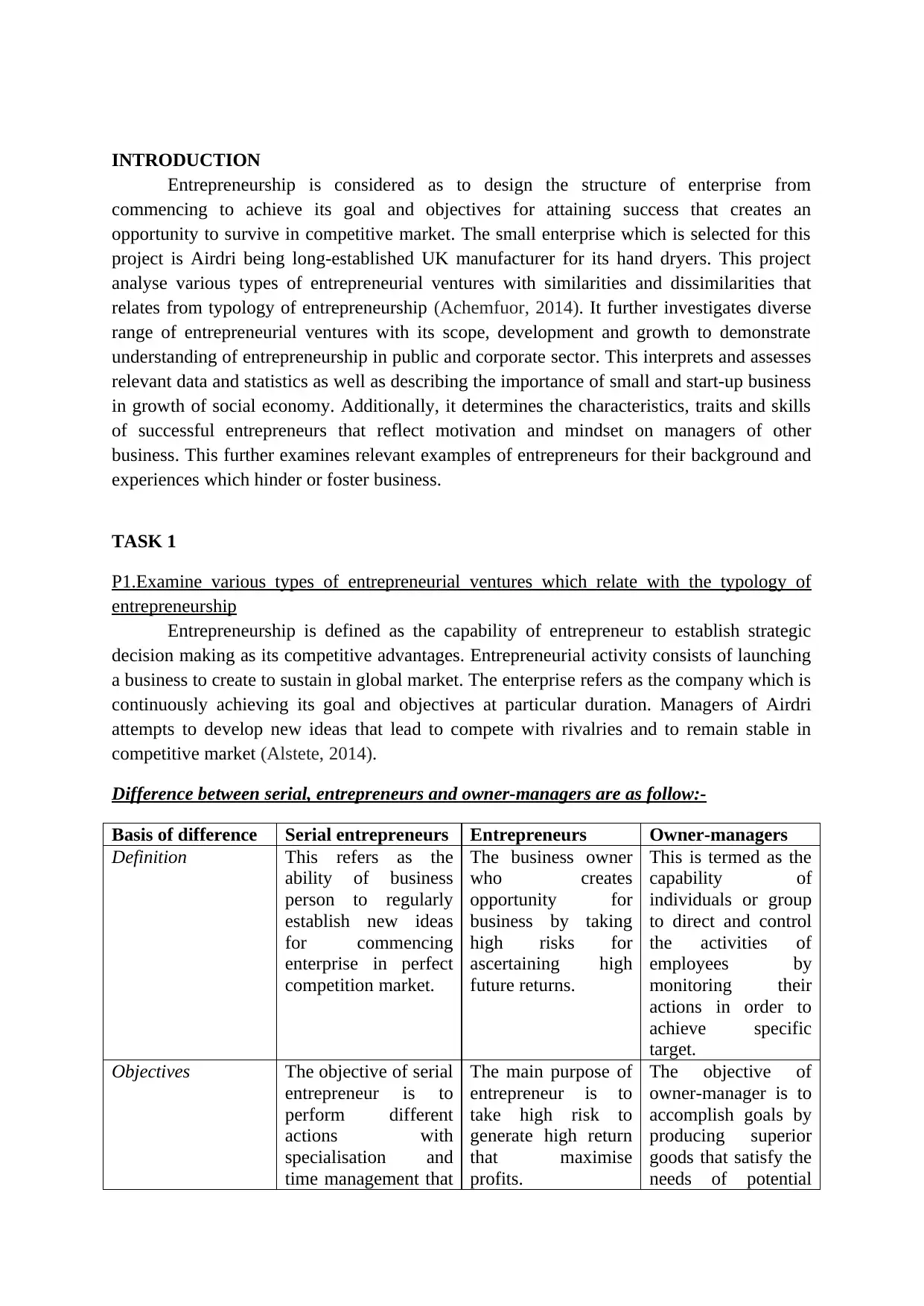
INTRODUCTION
Entrepreneurship is considered as to design the structure of enterprise from
commencing to achieve its goal and objectives for attaining success that creates an
opportunity to survive in competitive market. The small enterprise which is selected for this
project is Airdri being long-established UK manufacturer for its hand dryers. This project
analyse various types of entrepreneurial ventures with similarities and dissimilarities that
relates from typology of entrepreneurship (Achemfuor, 2014). It further investigates diverse
range of entrepreneurial ventures with its scope, development and growth to demonstrate
understanding of entrepreneurship in public and corporate sector. This interprets and assesses
relevant data and statistics as well as describing the importance of small and start-up business
in growth of social economy. Additionally, it determines the characteristics, traits and skills
of successful entrepreneurs that reflect motivation and mindset on managers of other
business. This further examines relevant examples of entrepreneurs for their background and
experiences which hinder or foster business.
TASK 1
P1.Examine various types of entrepreneurial ventures which relate with the typology of
entrepreneurship
Entrepreneurship is defined as the capability of entrepreneur to establish strategic
decision making as its competitive advantages. Entrepreneurial activity consists of launching
a business to create to sustain in global market. The enterprise refers as the company which is
continuously achieving its goal and objectives at particular duration. Managers of Airdri
attempts to develop new ideas that lead to compete with rivalries and to remain stable in
competitive market (Alstete, 2014).
Difference between serial, entrepreneurs and owner-managers are as follow:-
Basis of difference Serial entrepreneurs Entrepreneurs Owner-managers
Definition This refers as the
ability of business
person to regularly
establish new ideas
for commencing
enterprise in perfect
competition market.
The business owner
who creates
opportunity for
business by taking
high risks for
ascertaining high
future returns.
This is termed as the
capability of
individuals or group
to direct and control
the activities of
employees by
monitoring their
actions in order to
achieve specific
target.
Objectives The objective of serial
entrepreneur is to
perform different
actions with
specialisation and
time management that
The main purpose of
entrepreneur is to
take high risk to
generate high return
that maximise
profits.
The objective of
owner-manager is to
accomplish goals by
producing superior
goods that satisfy the
needs of potential
Entrepreneurship is considered as to design the structure of enterprise from
commencing to achieve its goal and objectives for attaining success that creates an
opportunity to survive in competitive market. The small enterprise which is selected for this
project is Airdri being long-established UK manufacturer for its hand dryers. This project
analyse various types of entrepreneurial ventures with similarities and dissimilarities that
relates from typology of entrepreneurship (Achemfuor, 2014). It further investigates diverse
range of entrepreneurial ventures with its scope, development and growth to demonstrate
understanding of entrepreneurship in public and corporate sector. This interprets and assesses
relevant data and statistics as well as describing the importance of small and start-up business
in growth of social economy. Additionally, it determines the characteristics, traits and skills
of successful entrepreneurs that reflect motivation and mindset on managers of other
business. This further examines relevant examples of entrepreneurs for their background and
experiences which hinder or foster business.
TASK 1
P1.Examine various types of entrepreneurial ventures which relate with the typology of
entrepreneurship
Entrepreneurship is defined as the capability of entrepreneur to establish strategic
decision making as its competitive advantages. Entrepreneurial activity consists of launching
a business to create to sustain in global market. The enterprise refers as the company which is
continuously achieving its goal and objectives at particular duration. Managers of Airdri
attempts to develop new ideas that lead to compete with rivalries and to remain stable in
competitive market (Alstete, 2014).
Difference between serial, entrepreneurs and owner-managers are as follow:-
Basis of difference Serial entrepreneurs Entrepreneurs Owner-managers
Definition This refers as the
ability of business
person to regularly
establish new ideas
for commencing
enterprise in perfect
competition market.
The business owner
who creates
opportunity for
business by taking
high risks for
ascertaining high
future returns.
This is termed as the
capability of
individuals or group
to direct and control
the activities of
employees by
monitoring their
actions in order to
achieve specific
target.
Objectives The objective of serial
entrepreneur is to
perform different
actions with
specialisation and
time management that
The main purpose of
entrepreneur is to
take high risk to
generate high return
that maximise
profits.
The objective of
owner-manager is to
accomplish goals by
producing superior
goods that satisfy the
needs of potential
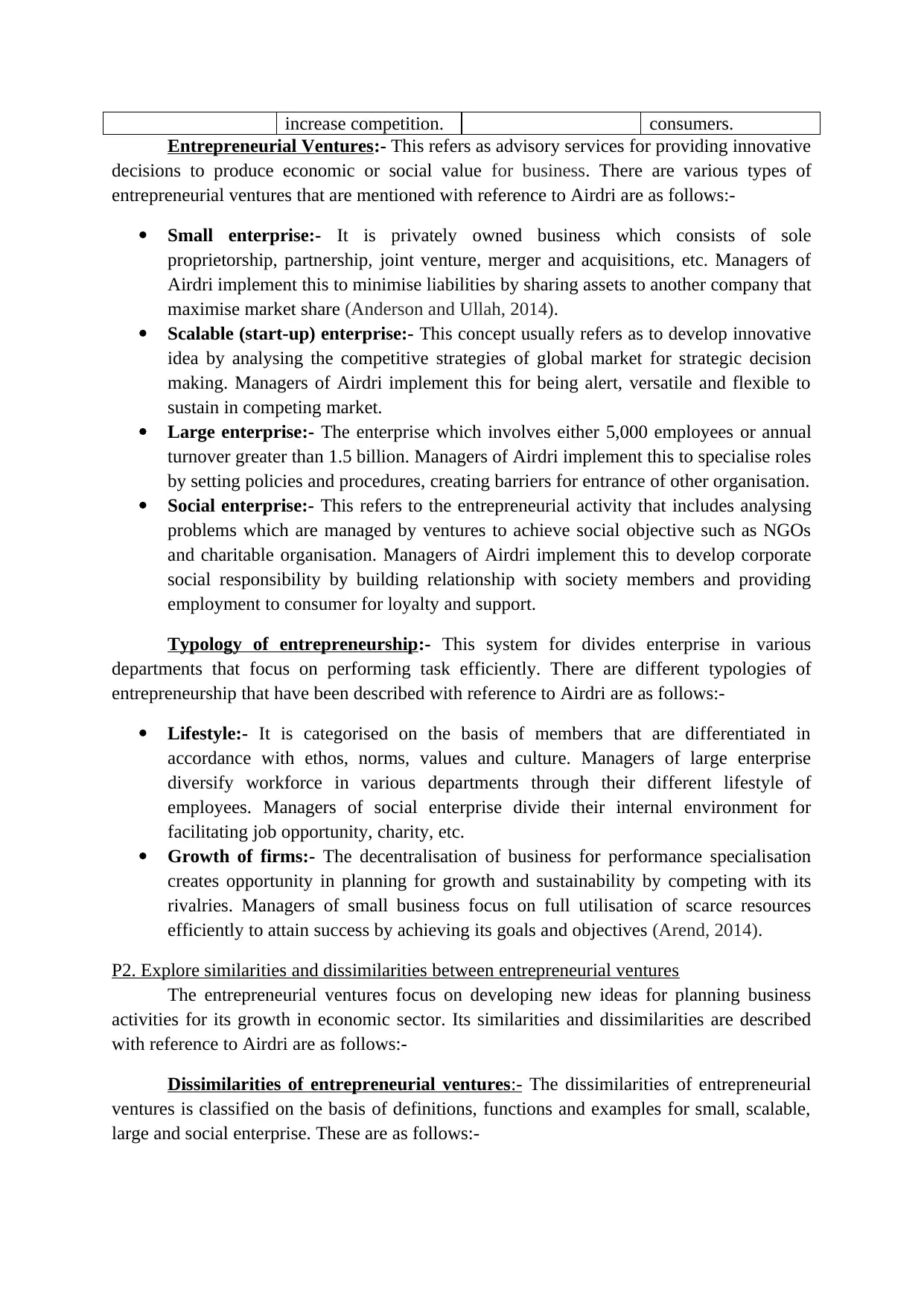
increase competition. consumers.
Entrepreneurial Ventures:- This refers as advisory services for providing innovative
decisions to produce economic or social value for business. There are various types of
entrepreneurial ventures that are mentioned with reference to Airdri are as follows:-
Small enterprise:- It is privately owned business which consists of sole
proprietorship, partnership, joint venture, merger and acquisitions, etc. Managers of
Airdri implement this to minimise liabilities by sharing assets to another company that
maximise market share (Anderson and Ullah, 2014).
Scalable (start-up) enterprise:- This concept usually refers as to develop innovative
idea by analysing the competitive strategies of global market for strategic decision
making. Managers of Airdri implement this for being alert, versatile and flexible to
sustain in competing market.
Large enterprise:- The enterprise which involves either 5,000 employees or annual
turnover greater than 1.5 billion. Managers of Airdri implement this to specialise roles
by setting policies and procedures, creating barriers for entrance of other organisation.
Social enterprise:- This refers to the entrepreneurial activity that includes analysing
problems which are managed by ventures to achieve social objective such as NGOs
and charitable organisation. Managers of Airdri implement this to develop corporate
social responsibility by building relationship with society members and providing
employment to consumer for loyalty and support.
Typology of entrepreneurship:- This system for divides enterprise in various
departments that focus on performing task efficiently. There are different typologies of
entrepreneurship that have been described with reference to Airdri are as follows:-
Lifestyle:- It is categorised on the basis of members that are differentiated in
accordance with ethos, norms, values and culture. Managers of large enterprise
diversify workforce in various departments through their different lifestyle of
employees. Managers of social enterprise divide their internal environment for
facilitating job opportunity, charity, etc.
Growth of firms:- The decentralisation of business for performance specialisation
creates opportunity in planning for growth and sustainability by competing with its
rivalries. Managers of small business focus on full utilisation of scarce resources
efficiently to attain success by achieving its goals and objectives (Arend, 2014).
P2. Explore similarities and dissimilarities between entrepreneurial ventures
The entrepreneurial ventures focus on developing new ideas for planning business
activities for its growth in economic sector. Its similarities and dissimilarities are described
with reference to Airdri are as follows:-
Dissimilarities of entrepreneurial ventures:- The dissimilarities of entrepreneurial
ventures is classified on the basis of definitions, functions and examples for small, scalable,
large and social enterprise. These are as follows:-
Entrepreneurial Ventures:- This refers as advisory services for providing innovative
decisions to produce economic or social value for business. There are various types of
entrepreneurial ventures that are mentioned with reference to Airdri are as follows:-
Small enterprise:- It is privately owned business which consists of sole
proprietorship, partnership, joint venture, merger and acquisitions, etc. Managers of
Airdri implement this to minimise liabilities by sharing assets to another company that
maximise market share (Anderson and Ullah, 2014).
Scalable (start-up) enterprise:- This concept usually refers as to develop innovative
idea by analysing the competitive strategies of global market for strategic decision
making. Managers of Airdri implement this for being alert, versatile and flexible to
sustain in competing market.
Large enterprise:- The enterprise which involves either 5,000 employees or annual
turnover greater than 1.5 billion. Managers of Airdri implement this to specialise roles
by setting policies and procedures, creating barriers for entrance of other organisation.
Social enterprise:- This refers to the entrepreneurial activity that includes analysing
problems which are managed by ventures to achieve social objective such as NGOs
and charitable organisation. Managers of Airdri implement this to develop corporate
social responsibility by building relationship with society members and providing
employment to consumer for loyalty and support.
Typology of entrepreneurship:- This system for divides enterprise in various
departments that focus on performing task efficiently. There are different typologies of
entrepreneurship that have been described with reference to Airdri are as follows:-
Lifestyle:- It is categorised on the basis of members that are differentiated in
accordance with ethos, norms, values and culture. Managers of large enterprise
diversify workforce in various departments through their different lifestyle of
employees. Managers of social enterprise divide their internal environment for
facilitating job opportunity, charity, etc.
Growth of firms:- The decentralisation of business for performance specialisation
creates opportunity in planning for growth and sustainability by competing with its
rivalries. Managers of small business focus on full utilisation of scarce resources
efficiently to attain success by achieving its goals and objectives (Arend, 2014).
P2. Explore similarities and dissimilarities between entrepreneurial ventures
The entrepreneurial ventures focus on developing new ideas for planning business
activities for its growth in economic sector. Its similarities and dissimilarities are described
with reference to Airdri are as follows:-
Dissimilarities of entrepreneurial ventures:- The dissimilarities of entrepreneurial
ventures is classified on the basis of definitions, functions and examples for small, scalable,
large and social enterprise. These are as follows:-
Secure Best Marks with AI Grader
Need help grading? Try our AI Grader for instant feedback on your assignments.

Basis of
difference
Small
enterprise
Scalable (Start-up)
enterprise
Large
enterprise
Social
enterprise
Definition It is privately
owned
business which
consists of sole
proprietorship,
partnership,
joint venture,
merger and
acquisitions,
etc.
This concept usually
refers as to develop
innovative idea by
analysing the
competitive strategies
of global market for
strategic decision
making.
The enterprise
which
involves
either 5,000
employees or
annual
turnover
greater than
1.5 billion.
This refers to
the
entrepreneurial
activity that
includes
analysing
problems which
are managed by
ventures to
achieve social
objective such
as NGOs and
charitable
organisation.
Function Its function is
to achieve both
short and long-
term goals and
objectives.
It is the new enterprise
established by one or
more business owners
by developing
differentiated product
to meet requirements
of potential
consumers.
It functions to
run business
smoothly
through its
various
departments
that increase
efficiency for
achieving
success.
The function of
social enterprise
is to attain
specific
objective by
funding social
programs for
charity and
developing job
opportunity.
Example The example
of Small
enterprise are
David
Canners,
Fourex, etc.
Its examples are
Videoplaza, IOVOX,
etc.
The example
of large
enterprise are
TESCO,
Aviva, HSBC
Holdings, etc.
Its examples are
Higher Rhythm
Ltd, Barnsley
Community
Build, CASA,
etc.
Similarities of Entrepreneurial ventures are:- The similarities are explained for
small, start-up, large and social enterprise with reference to Airdri are as follows:-
Utilisation of scarce resources:- The organisation attempts to utilise scarce resources
effectively as it develops competitive strategies for the growth and survival. Managers
of Airdri implement this to achieve success by competing with rivalries to remain
stable in global market (Elo and Hieta, 2017).
Consumer services:- The enterprise targets to maximise revenue and profit-margin
by distributing their products at least-cost effectiveness for their customers. Managers
of Airdri focus on building relationships with target audience by providing finished
goods through direct and indirect channel of distribution to remove the hindrance of
place. This enlarges consumer loyalty and support for the qualitative product at which
they are ready to pay high prices.
difference
Small
enterprise
Scalable (Start-up)
enterprise
Large
enterprise
Social
enterprise
Definition It is privately
owned
business which
consists of sole
proprietorship,
partnership,
joint venture,
merger and
acquisitions,
etc.
This concept usually
refers as to develop
innovative idea by
analysing the
competitive strategies
of global market for
strategic decision
making.
The enterprise
which
involves
either 5,000
employees or
annual
turnover
greater than
1.5 billion.
This refers to
the
entrepreneurial
activity that
includes
analysing
problems which
are managed by
ventures to
achieve social
objective such
as NGOs and
charitable
organisation.
Function Its function is
to achieve both
short and long-
term goals and
objectives.
It is the new enterprise
established by one or
more business owners
by developing
differentiated product
to meet requirements
of potential
consumers.
It functions to
run business
smoothly
through its
various
departments
that increase
efficiency for
achieving
success.
The function of
social enterprise
is to attain
specific
objective by
funding social
programs for
charity and
developing job
opportunity.
Example The example
of Small
enterprise are
David
Canners,
Fourex, etc.
Its examples are
Videoplaza, IOVOX,
etc.
The example
of large
enterprise are
TESCO,
Aviva, HSBC
Holdings, etc.
Its examples are
Higher Rhythm
Ltd, Barnsley
Community
Build, CASA,
etc.
Similarities of Entrepreneurial ventures are:- The similarities are explained for
small, start-up, large and social enterprise with reference to Airdri are as follows:-
Utilisation of scarce resources:- The organisation attempts to utilise scarce resources
effectively as it develops competitive strategies for the growth and survival. Managers
of Airdri implement this to achieve success by competing with rivalries to remain
stable in global market (Elo and Hieta, 2017).
Consumer services:- The enterprise targets to maximise revenue and profit-margin
by distributing their products at least-cost effectiveness for their customers. Managers
of Airdri focus on building relationships with target audience by providing finished
goods through direct and indirect channel of distribution to remove the hindrance of
place. This enlarges consumer loyalty and support for the qualitative product at which
they are ready to pay high prices.

M1. Investigate diverse range of entrepreneurial ventures to demonstrate understanding of
entrepreneurship in public and corporate sector
Public sector:- It is defined as composition of services and enterprises that involves
infrastructure, education, health care, transportation, military services, etc.
Corporate sector:- It is the element of domestic economy which excludes
government interference, non-profit organisation, serving individuals, etc.
There are diverse range of entrepreneurial ventures that demonstrate an understanding
in both public and corporate sector which are as follows:-
Merger and Acquisitions:- This is considered as merger of two business sharing
their liabilities and assets to form one business whereas acquisitions is described as
acquiring of whole business by another which enhance market share. Managers of
Airdri demonstrate merger and acquisition at the time of dissolving business which
creates opportunity to survive and remain stable in competitive market (Fatoki, 2014).
Joint Ventures:- It is referred as consisting of two or more entrepreneurs performing
their tasks actively to ascertain specific goal effectively for achievement of success.
Managers of Airdri demonstrate an understanding for joint venture for division of
work in accordance to their sharing of profitability ratios.
TASK 2
P3, Interpret and assess relevant data and statistics that illustrates how micro and small
business impact on economy
Micro Business:- It is considered as the component of small business which involves
annual sales and assets less than $250,000 as well as fewer five employees that also include
owner.
The relevant data and statistics of micro and small business which impact the growth
of economy are as follows:-
Interpretation:-
The small business is highly applicable in production and construction which is
shown in prescribed graph that is high as compared to medium and large business. It creates
entrepreneurship in public and corporate sector
Public sector:- It is defined as composition of services and enterprises that involves
infrastructure, education, health care, transportation, military services, etc.
Corporate sector:- It is the element of domestic economy which excludes
government interference, non-profit organisation, serving individuals, etc.
There are diverse range of entrepreneurial ventures that demonstrate an understanding
in both public and corporate sector which are as follows:-
Merger and Acquisitions:- This is considered as merger of two business sharing
their liabilities and assets to form one business whereas acquisitions is described as
acquiring of whole business by another which enhance market share. Managers of
Airdri demonstrate merger and acquisition at the time of dissolving business which
creates opportunity to survive and remain stable in competitive market (Fatoki, 2014).
Joint Ventures:- It is referred as consisting of two or more entrepreneurs performing
their tasks actively to ascertain specific goal effectively for achievement of success.
Managers of Airdri demonstrate an understanding for joint venture for division of
work in accordance to their sharing of profitability ratios.
TASK 2
P3, Interpret and assess relevant data and statistics that illustrates how micro and small
business impact on economy
Micro Business:- It is considered as the component of small business which involves
annual sales and assets less than $250,000 as well as fewer five employees that also include
owner.
The relevant data and statistics of micro and small business which impact the growth
of economy are as follows:-
Interpretation:-
The small business is highly applicable in production and construction which is
shown in prescribed graph that is high as compared to medium and large business. It creates

opportunity for growth of business in economic development by providing services to small
business which plays major role in meeting the needs, desire and wants of consumer for
maximisation of revenue and profits rather than medium and large enterprises (Hafer and
Jones, 2015).
P4.Explain the importance of small and start-up business in growth of social economy
Small Business:- It is defined as privately owned business which is not governed by
government. This involves sole proprietorship, partnership, joint venture, merger and
acquisitions, etc. Managers of Airdri implement this business to share their liabilities and
assets to other organisation for reducing debts.
Importance of small business:- This enterprise plays very essential role in
accomplishment of organisational goals and objectives by meeting the requirements of
consumers in providing high level of satisfaction. Its importance is mentioned with reference
to Airdri are as follows:-
Develop corporate social responsibility (CSR):- It positively affects the business by
develop the corporate social responsibility through providing safety measures from
environment pollution, creating job opportunities, etc. Managers of Airdri focus on
developing CSR through protecting environment from pollution, wastage disposal,
etc., which creates good reputation of enterprise in society.
Increase competition:- This focus on increasing large number of competition as
being aware of the new entrants in the global market that may affects its stability.
Managers of small business such as Airdri analyse the competitive strategies implied
by its rivalries that may cause threats to the organisation. It is beneficial for planning
growth of enterprise by taking precautionary steps in restricting uncontrollable risk.
Start-up Business:- This is defined as the business which is developed through
innovative ideas for strategic decision making that commence by investments for generating
capital. Managers of Airdri focus on this to utilise scarce resources effectively by entering
into global market through its specific product (Jones, 2014).
Importance of start-up business:- The scalable business plays the major role for
growth and expansion of business in achievement of success. Its importance is mentioned
with reference to Airdri are as follows:-
Innovative Idea:- It is the capability of business owner to develop new idea for
planning to compete with rivalries through their competitive strategies. Managers of
Start-up business develop innovative idea that increases its strategies from internal
strength and external opportunities to overcome weakness and threats. Example:-
Revolut, Igloo, Elder, etc.
Increase GDP:- It creates growth opportunity for gross development product for
restricting foreign direct investment by entrance of new firms in the country that
reduce import and increase exports. Managers of start-up business are beneficial with
increase in GDP as it develops monopoly in global market with high pricing strategy
business which plays major role in meeting the needs, desire and wants of consumer for
maximisation of revenue and profits rather than medium and large enterprises (Hafer and
Jones, 2015).
P4.Explain the importance of small and start-up business in growth of social economy
Small Business:- It is defined as privately owned business which is not governed by
government. This involves sole proprietorship, partnership, joint venture, merger and
acquisitions, etc. Managers of Airdri implement this business to share their liabilities and
assets to other organisation for reducing debts.
Importance of small business:- This enterprise plays very essential role in
accomplishment of organisational goals and objectives by meeting the requirements of
consumers in providing high level of satisfaction. Its importance is mentioned with reference
to Airdri are as follows:-
Develop corporate social responsibility (CSR):- It positively affects the business by
develop the corporate social responsibility through providing safety measures from
environment pollution, creating job opportunities, etc. Managers of Airdri focus on
developing CSR through protecting environment from pollution, wastage disposal,
etc., which creates good reputation of enterprise in society.
Increase competition:- This focus on increasing large number of competition as
being aware of the new entrants in the global market that may affects its stability.
Managers of small business such as Airdri analyse the competitive strategies implied
by its rivalries that may cause threats to the organisation. It is beneficial for planning
growth of enterprise by taking precautionary steps in restricting uncontrollable risk.
Start-up Business:- This is defined as the business which is developed through
innovative ideas for strategic decision making that commence by investments for generating
capital. Managers of Airdri focus on this to utilise scarce resources effectively by entering
into global market through its specific product (Jones, 2014).
Importance of start-up business:- The scalable business plays the major role for
growth and expansion of business in achievement of success. Its importance is mentioned
with reference to Airdri are as follows:-
Innovative Idea:- It is the capability of business owner to develop new idea for
planning to compete with rivalries through their competitive strategies. Managers of
Start-up business develop innovative idea that increases its strategies from internal
strength and external opportunities to overcome weakness and threats. Example:-
Revolut, Igloo, Elder, etc.
Increase GDP:- It creates growth opportunity for gross development product for
restricting foreign direct investment by entrance of new firms in the country that
reduce import and increase exports. Managers of start-up business are beneficial with
increase in GDP as it develops monopoly in global market with high pricing strategy
Paraphrase This Document
Need a fresh take? Get an instant paraphrase of this document with our AI Paraphraser
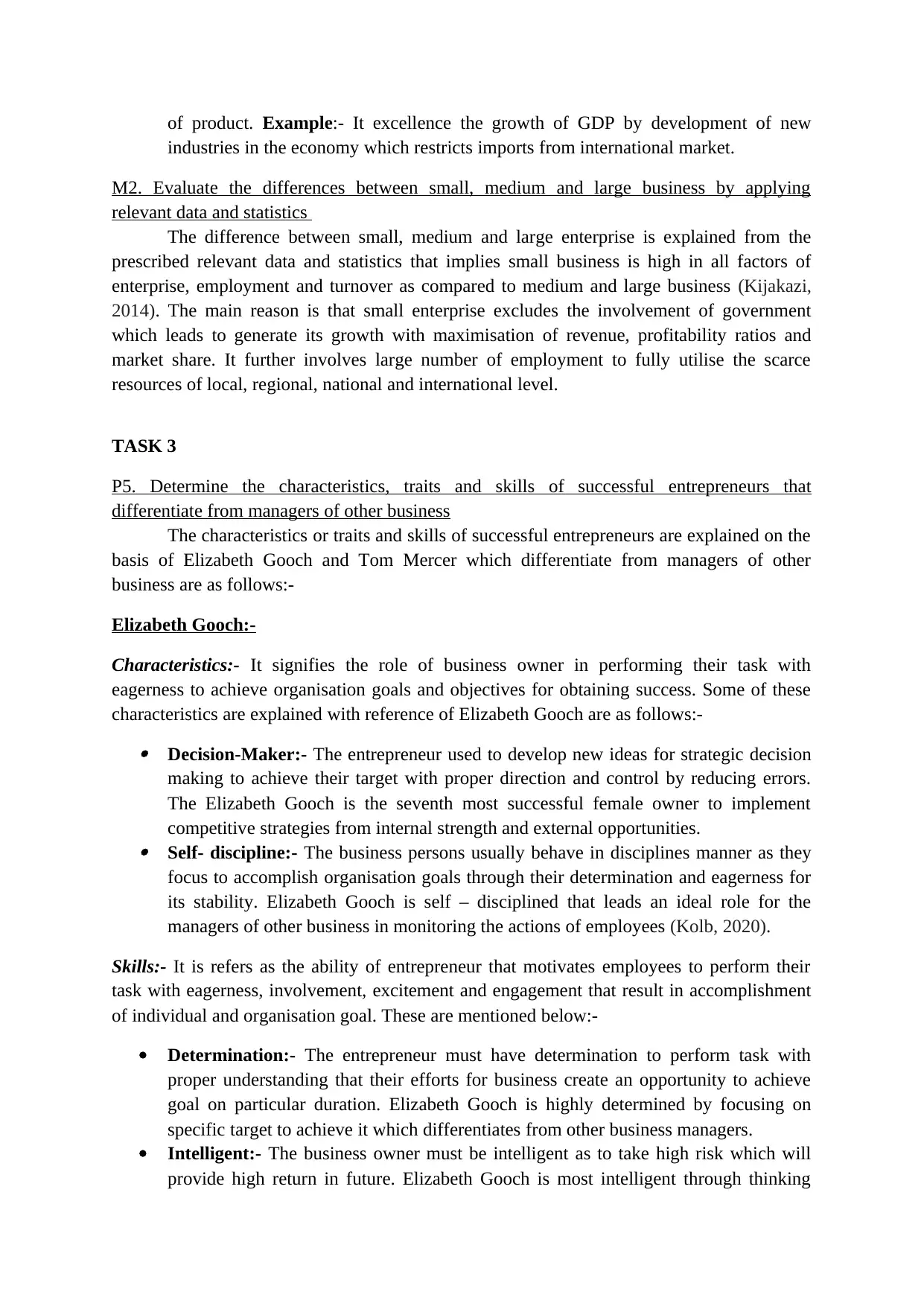
of product. Example:- It excellence the growth of GDP by development of new
industries in the economy which restricts imports from international market.
M2. Evaluate the differences between small, medium and large business by applying
relevant data and statistics
The difference between small, medium and large enterprise is explained from the
prescribed relevant data and statistics that implies small business is high in all factors of
enterprise, employment and turnover as compared to medium and large business (Kijakazi,
2014). The main reason is that small enterprise excludes the involvement of government
which leads to generate its growth with maximisation of revenue, profitability ratios and
market share. It further involves large number of employment to fully utilise the scarce
resources of local, regional, national and international level.
TASK 3
P5. Determine the characteristics, traits and skills of successful entrepreneurs that
differentiate from managers of other business
The characteristics or traits and skills of successful entrepreneurs are explained on the
basis of Elizabeth Gooch and Tom Mercer which differentiate from managers of other
business are as follows:-
Elizabeth Gooch:-
Characteristics:- It signifies the role of business owner in performing their task with
eagerness to achieve organisation goals and objectives for obtaining success. Some of these
characteristics are explained with reference of Elizabeth Gooch are as follows:- Decision-Maker:- The entrepreneur used to develop new ideas for strategic decision
making to achieve their target with proper direction and control by reducing errors.
The Elizabeth Gooch is the seventh most successful female owner to implement
competitive strategies from internal strength and external opportunities.
Self- discipline:- The business persons usually behave in disciplines manner as they
focus to accomplish organisation goals through their determination and eagerness for
its stability. Elizabeth Gooch is self – disciplined that leads an ideal role for the
managers of other business in monitoring the actions of employees (Kolb, 2020).
Skills:- It is refers as the ability of entrepreneur that motivates employees to perform their
task with eagerness, involvement, excitement and engagement that result in accomplishment
of individual and organisation goal. These are mentioned below:-
Determination:- The entrepreneur must have determination to perform task with
proper understanding that their efforts for business create an opportunity to achieve
goal on particular duration. Elizabeth Gooch is highly determined by focusing on
specific target to achieve it which differentiates from other business managers.
Intelligent:- The business owner must be intelligent as to take high risk which will
provide high return in future. Elizabeth Gooch is most intelligent through thinking
industries in the economy which restricts imports from international market.
M2. Evaluate the differences between small, medium and large business by applying
relevant data and statistics
The difference between small, medium and large enterprise is explained from the
prescribed relevant data and statistics that implies small business is high in all factors of
enterprise, employment and turnover as compared to medium and large business (Kijakazi,
2014). The main reason is that small enterprise excludes the involvement of government
which leads to generate its growth with maximisation of revenue, profitability ratios and
market share. It further involves large number of employment to fully utilise the scarce
resources of local, regional, national and international level.
TASK 3
P5. Determine the characteristics, traits and skills of successful entrepreneurs that
differentiate from managers of other business
The characteristics or traits and skills of successful entrepreneurs are explained on the
basis of Elizabeth Gooch and Tom Mercer which differentiate from managers of other
business are as follows:-
Elizabeth Gooch:-
Characteristics:- It signifies the role of business owner in performing their task with
eagerness to achieve organisation goals and objectives for obtaining success. Some of these
characteristics are explained with reference of Elizabeth Gooch are as follows:- Decision-Maker:- The entrepreneur used to develop new ideas for strategic decision
making to achieve their target with proper direction and control by reducing errors.
The Elizabeth Gooch is the seventh most successful female owner to implement
competitive strategies from internal strength and external opportunities.
Self- discipline:- The business persons usually behave in disciplines manner as they
focus to accomplish organisation goals through their determination and eagerness for
its stability. Elizabeth Gooch is self – disciplined that leads an ideal role for the
managers of other business in monitoring the actions of employees (Kolb, 2020).
Skills:- It is refers as the ability of entrepreneur that motivates employees to perform their
task with eagerness, involvement, excitement and engagement that result in accomplishment
of individual and organisation goal. These are mentioned below:-
Determination:- The entrepreneur must have determination to perform task with
proper understanding that their efforts for business create an opportunity to achieve
goal on particular duration. Elizabeth Gooch is highly determined by focusing on
specific target to achieve it which differentiates from other business managers.
Intelligent:- The business owner must be intelligent as to take high risk which will
provide high return in future. Elizabeth Gooch is most intelligent through thinking
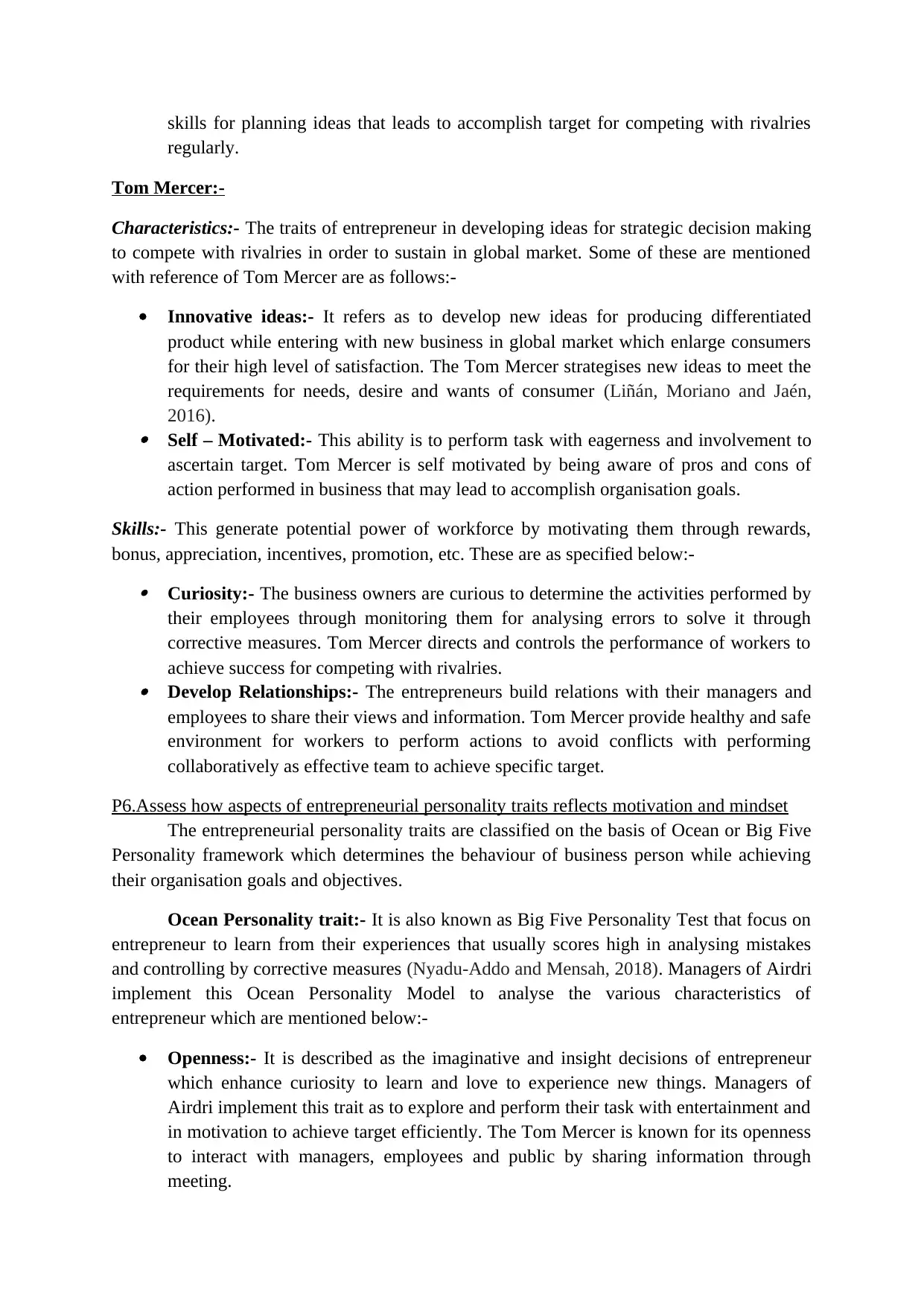
skills for planning ideas that leads to accomplish target for competing with rivalries
regularly.
Tom Mercer:-
Characteristics:- The traits of entrepreneur in developing ideas for strategic decision making
to compete with rivalries in order to sustain in global market. Some of these are mentioned
with reference of Tom Mercer are as follows:-
Innovative ideas:- It refers as to develop new ideas for producing differentiated
product while entering with new business in global market which enlarge consumers
for their high level of satisfaction. The Tom Mercer strategises new ideas to meet the
requirements for needs, desire and wants of consumer (Liñán, Moriano and Jaén,
2016).
Self – Motivated:- This ability is to perform task with eagerness and involvement to
ascertain target. Tom Mercer is self motivated by being aware of pros and cons of
action performed in business that may lead to accomplish organisation goals.
Skills:- This generate potential power of workforce by motivating them through rewards,
bonus, appreciation, incentives, promotion, etc. These are as specified below:- Curiosity:- The business owners are curious to determine the activities performed by
their employees through monitoring them for analysing errors to solve it through
corrective measures. Tom Mercer directs and controls the performance of workers to
achieve success for competing with rivalries.
Develop Relationships:- The entrepreneurs build relations with their managers and
employees to share their views and information. Tom Mercer provide healthy and safe
environment for workers to perform actions to avoid conflicts with performing
collaboratively as effective team to achieve specific target.
P6.Assess how aspects of entrepreneurial personality traits reflects motivation and mindset
The entrepreneurial personality traits are classified on the basis of Ocean or Big Five
Personality framework which determines the behaviour of business person while achieving
their organisation goals and objectives.
Ocean Personality trait:- It is also known as Big Five Personality Test that focus on
entrepreneur to learn from their experiences that usually scores high in analysing mistakes
and controlling by corrective measures (Nyadu-Addo and Mensah, 2018). Managers of Airdri
implement this Ocean Personality Model to analyse the various characteristics of
entrepreneur which are mentioned below:-
Openness:- It is described as the imaginative and insight decisions of entrepreneur
which enhance curiosity to learn and love to experience new things. Managers of
Airdri implement this trait as to explore and perform their task with entertainment and
in motivation to achieve target efficiently. The Tom Mercer is known for its openness
to interact with managers, employees and public by sharing information through
meeting.
regularly.
Tom Mercer:-
Characteristics:- The traits of entrepreneur in developing ideas for strategic decision making
to compete with rivalries in order to sustain in global market. Some of these are mentioned
with reference of Tom Mercer are as follows:-
Innovative ideas:- It refers as to develop new ideas for producing differentiated
product while entering with new business in global market which enlarge consumers
for their high level of satisfaction. The Tom Mercer strategises new ideas to meet the
requirements for needs, desire and wants of consumer (Liñán, Moriano and Jaén,
2016).
Self – Motivated:- This ability is to perform task with eagerness and involvement to
ascertain target. Tom Mercer is self motivated by being aware of pros and cons of
action performed in business that may lead to accomplish organisation goals.
Skills:- This generate potential power of workforce by motivating them through rewards,
bonus, appreciation, incentives, promotion, etc. These are as specified below:- Curiosity:- The business owners are curious to determine the activities performed by
their employees through monitoring them for analysing errors to solve it through
corrective measures. Tom Mercer directs and controls the performance of workers to
achieve success for competing with rivalries.
Develop Relationships:- The entrepreneurs build relations with their managers and
employees to share their views and information. Tom Mercer provide healthy and safe
environment for workers to perform actions to avoid conflicts with performing
collaboratively as effective team to achieve specific target.
P6.Assess how aspects of entrepreneurial personality traits reflects motivation and mindset
The entrepreneurial personality traits are classified on the basis of Ocean or Big Five
Personality framework which determines the behaviour of business person while achieving
their organisation goals and objectives.
Ocean Personality trait:- It is also known as Big Five Personality Test that focus on
entrepreneur to learn from their experiences that usually scores high in analysing mistakes
and controlling by corrective measures (Nyadu-Addo and Mensah, 2018). Managers of Airdri
implement this Ocean Personality Model to analyse the various characteristics of
entrepreneur which are mentioned below:-
Openness:- It is described as the imaginative and insight decisions of entrepreneur
which enhance curiosity to learn and love to experience new things. Managers of
Airdri implement this trait as to explore and perform their task with entertainment and
in motivation to achieve target efficiently. The Tom Mercer is known for its openness
to interact with managers, employees and public by sharing information through
meeting.
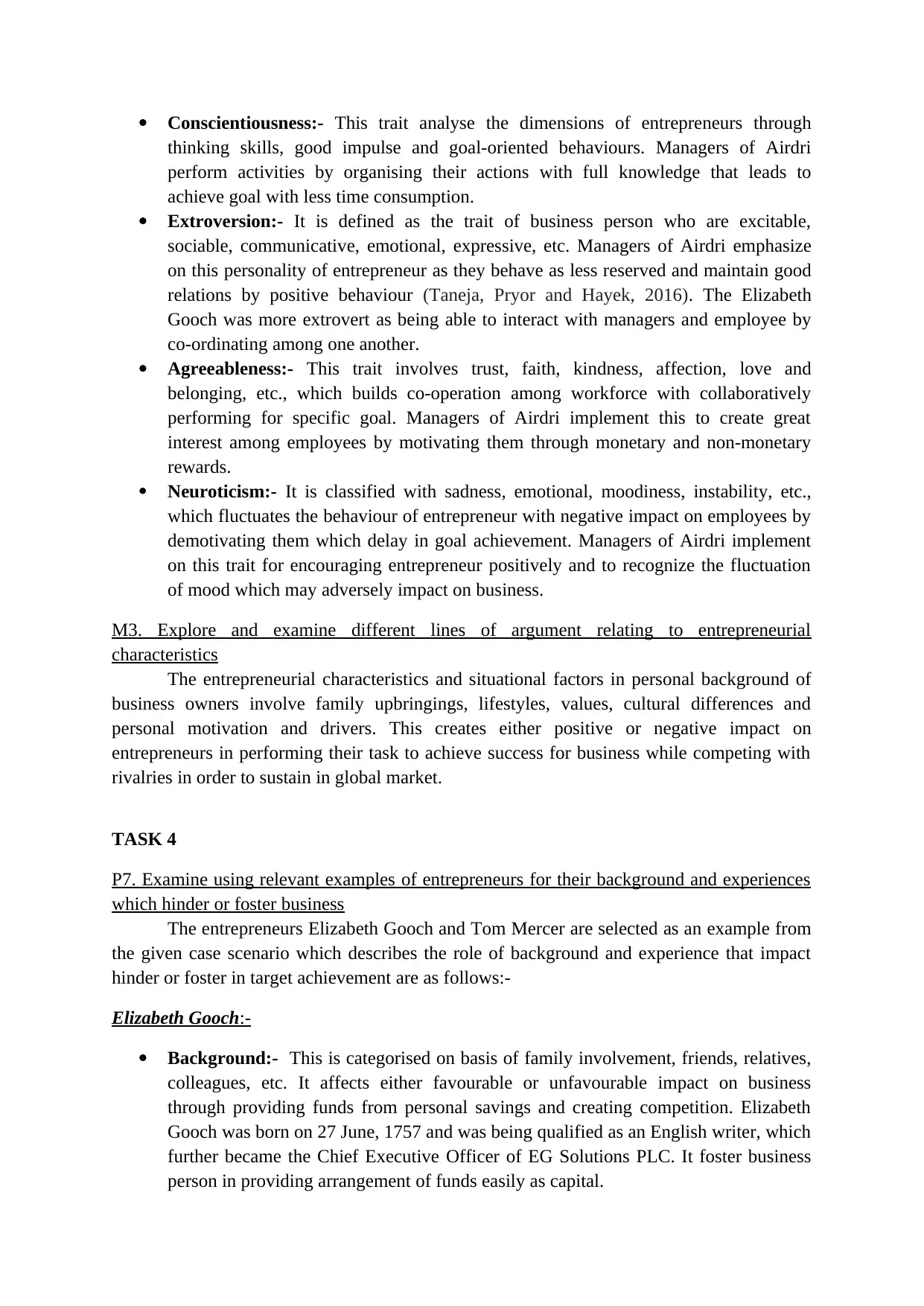
Conscientiousness:- This trait analyse the dimensions of entrepreneurs through
thinking skills, good impulse and goal-oriented behaviours. Managers of Airdri
perform activities by organising their actions with full knowledge that leads to
achieve goal with less time consumption.
Extroversion:- It is defined as the trait of business person who are excitable,
sociable, communicative, emotional, expressive, etc. Managers of Airdri emphasize
on this personality of entrepreneur as they behave as less reserved and maintain good
relations by positive behaviour (Taneja, Pryor and Hayek, 2016). The Elizabeth
Gooch was more extrovert as being able to interact with managers and employee by
co-ordinating among one another.
Agreeableness:- This trait involves trust, faith, kindness, affection, love and
belonging, etc., which builds co-operation among workforce with collaboratively
performing for specific goal. Managers of Airdri implement this to create great
interest among employees by motivating them through monetary and non-monetary
rewards.
Neuroticism:- It is classified with sadness, emotional, moodiness, instability, etc.,
which fluctuates the behaviour of entrepreneur with negative impact on employees by
demotivating them which delay in goal achievement. Managers of Airdri implement
on this trait for encouraging entrepreneur positively and to recognize the fluctuation
of mood which may adversely impact on business.
M3. Explore and examine different lines of argument relating to entrepreneurial
characteristics
The entrepreneurial characteristics and situational factors in personal background of
business owners involve family upbringings, lifestyles, values, cultural differences and
personal motivation and drivers. This creates either positive or negative impact on
entrepreneurs in performing their task to achieve success for business while competing with
rivalries in order to sustain in global market.
TASK 4
P7. Examine using relevant examples of entrepreneurs for their background and experiences
which hinder or foster business
The entrepreneurs Elizabeth Gooch and Tom Mercer are selected as an example from
the given case scenario which describes the role of background and experience that impact
hinder or foster in target achievement are as follows:-
Elizabeth Gooch:-
Background:- This is categorised on basis of family involvement, friends, relatives,
colleagues, etc. It affects either favourable or unfavourable impact on business
through providing funds from personal savings and creating competition. Elizabeth
Gooch was born on 27 June, 1757 and was being qualified as an English writer, which
further became the Chief Executive Officer of EG Solutions PLC. It foster business
person in providing arrangement of funds easily as capital.
thinking skills, good impulse and goal-oriented behaviours. Managers of Airdri
perform activities by organising their actions with full knowledge that leads to
achieve goal with less time consumption.
Extroversion:- It is defined as the trait of business person who are excitable,
sociable, communicative, emotional, expressive, etc. Managers of Airdri emphasize
on this personality of entrepreneur as they behave as less reserved and maintain good
relations by positive behaviour (Taneja, Pryor and Hayek, 2016). The Elizabeth
Gooch was more extrovert as being able to interact with managers and employee by
co-ordinating among one another.
Agreeableness:- This trait involves trust, faith, kindness, affection, love and
belonging, etc., which builds co-operation among workforce with collaboratively
performing for specific goal. Managers of Airdri implement this to create great
interest among employees by motivating them through monetary and non-monetary
rewards.
Neuroticism:- It is classified with sadness, emotional, moodiness, instability, etc.,
which fluctuates the behaviour of entrepreneur with negative impact on employees by
demotivating them which delay in goal achievement. Managers of Airdri implement
on this trait for encouraging entrepreneur positively and to recognize the fluctuation
of mood which may adversely impact on business.
M3. Explore and examine different lines of argument relating to entrepreneurial
characteristics
The entrepreneurial characteristics and situational factors in personal background of
business owners involve family upbringings, lifestyles, values, cultural differences and
personal motivation and drivers. This creates either positive or negative impact on
entrepreneurs in performing their task to achieve success for business while competing with
rivalries in order to sustain in global market.
TASK 4
P7. Examine using relevant examples of entrepreneurs for their background and experiences
which hinder or foster business
The entrepreneurs Elizabeth Gooch and Tom Mercer are selected as an example from
the given case scenario which describes the role of background and experience that impact
hinder or foster in target achievement are as follows:-
Elizabeth Gooch:-
Background:- This is categorised on basis of family involvement, friends, relatives,
colleagues, etc. It affects either favourable or unfavourable impact on business
through providing funds from personal savings and creating competition. Elizabeth
Gooch was born on 27 June, 1757 and was being qualified as an English writer, which
further became the Chief Executive Officer of EG Solutions PLC. It foster business
person in providing arrangement of funds easily as capital.
Secure Best Marks with AI Grader
Need help grading? Try our AI Grader for instant feedback on your assignments.
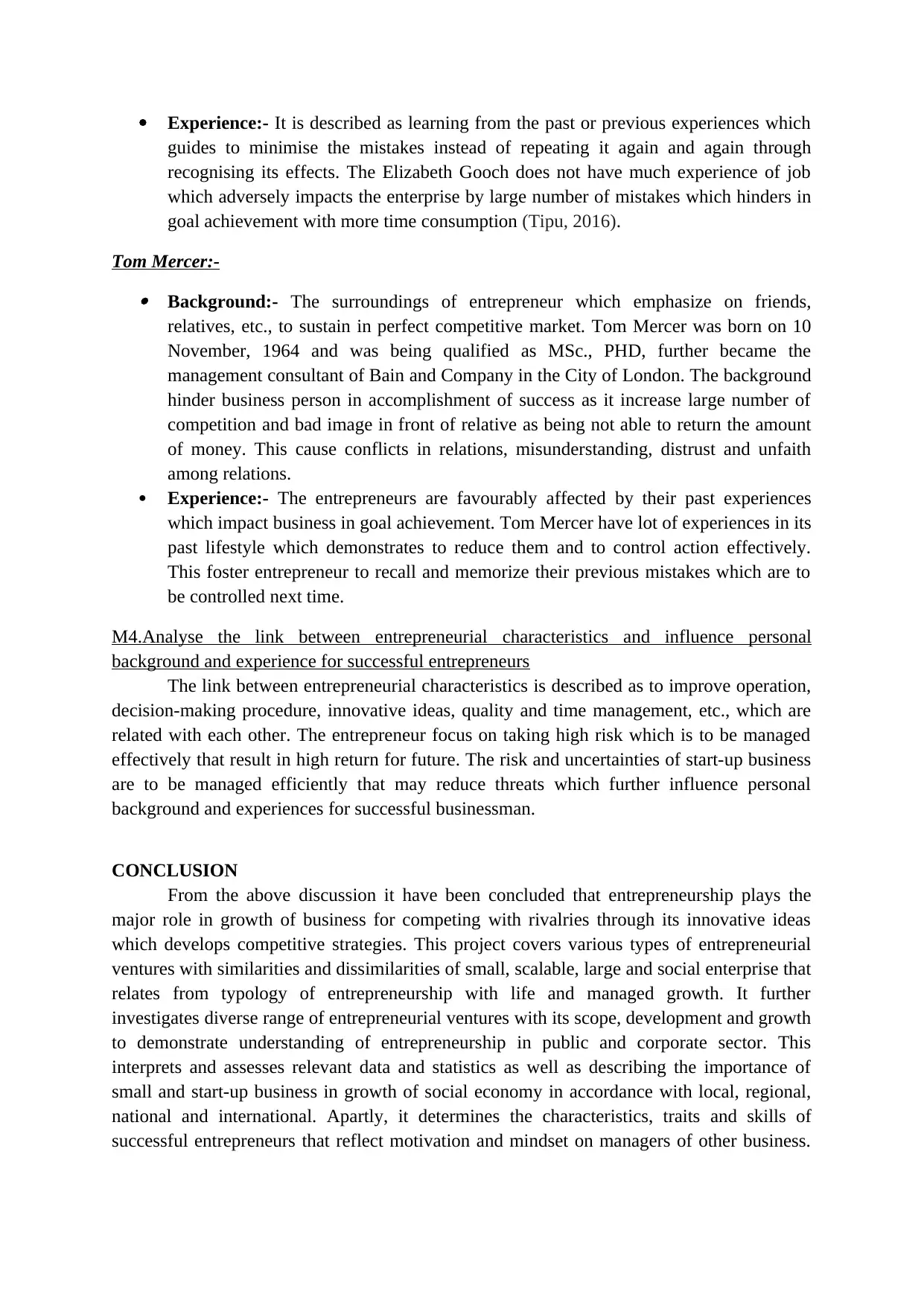
Experience:- It is described as learning from the past or previous experiences which
guides to minimise the mistakes instead of repeating it again and again through
recognising its effects. The Elizabeth Gooch does not have much experience of job
which adversely impacts the enterprise by large number of mistakes which hinders in
goal achievement with more time consumption (Tipu, 2016).
Tom Mercer:- Background:- The surroundings of entrepreneur which emphasize on friends,
relatives, etc., to sustain in perfect competitive market. Tom Mercer was born on 10
November, 1964 and was being qualified as MSc., PHD, further became the
management consultant of Bain and Company in the City of London. The background
hinder business person in accomplishment of success as it increase large number of
competition and bad image in front of relative as being not able to return the amount
of money. This cause conflicts in relations, misunderstanding, distrust and unfaith
among relations.
Experience:- The entrepreneurs are favourably affected by their past experiences
which impact business in goal achievement. Tom Mercer have lot of experiences in its
past lifestyle which demonstrates to reduce them and to control action effectively.
This foster entrepreneur to recall and memorize their previous mistakes which are to
be controlled next time.
M4.Analyse the link between entrepreneurial characteristics and influence personal
background and experience for successful entrepreneurs
The link between entrepreneurial characteristics is described as to improve operation,
decision-making procedure, innovative ideas, quality and time management, etc., which are
related with each other. The entrepreneur focus on taking high risk which is to be managed
effectively that result in high return for future. The risk and uncertainties of start-up business
are to be managed efficiently that may reduce threats which further influence personal
background and experiences for successful businessman.
CONCLUSION
From the above discussion it have been concluded that entrepreneurship plays the
major role in growth of business for competing with rivalries through its innovative ideas
which develops competitive strategies. This project covers various types of entrepreneurial
ventures with similarities and dissimilarities of small, scalable, large and social enterprise that
relates from typology of entrepreneurship with life and managed growth. It further
investigates diverse range of entrepreneurial ventures with its scope, development and growth
to demonstrate understanding of entrepreneurship in public and corporate sector. This
interprets and assesses relevant data and statistics as well as describing the importance of
small and start-up business in growth of social economy in accordance with local, regional,
national and international. Apartly, it determines the characteristics, traits and skills of
successful entrepreneurs that reflect motivation and mindset on managers of other business.
guides to minimise the mistakes instead of repeating it again and again through
recognising its effects. The Elizabeth Gooch does not have much experience of job
which adversely impacts the enterprise by large number of mistakes which hinders in
goal achievement with more time consumption (Tipu, 2016).
Tom Mercer:- Background:- The surroundings of entrepreneur which emphasize on friends,
relatives, etc., to sustain in perfect competitive market. Tom Mercer was born on 10
November, 1964 and was being qualified as MSc., PHD, further became the
management consultant of Bain and Company in the City of London. The background
hinder business person in accomplishment of success as it increase large number of
competition and bad image in front of relative as being not able to return the amount
of money. This cause conflicts in relations, misunderstanding, distrust and unfaith
among relations.
Experience:- The entrepreneurs are favourably affected by their past experiences
which impact business in goal achievement. Tom Mercer have lot of experiences in its
past lifestyle which demonstrates to reduce them and to control action effectively.
This foster entrepreneur to recall and memorize their previous mistakes which are to
be controlled next time.
M4.Analyse the link between entrepreneurial characteristics and influence personal
background and experience for successful entrepreneurs
The link between entrepreneurial characteristics is described as to improve operation,
decision-making procedure, innovative ideas, quality and time management, etc., which are
related with each other. The entrepreneur focus on taking high risk which is to be managed
effectively that result in high return for future. The risk and uncertainties of start-up business
are to be managed efficiently that may reduce threats which further influence personal
background and experiences for successful businessman.
CONCLUSION
From the above discussion it have been concluded that entrepreneurship plays the
major role in growth of business for competing with rivalries through its innovative ideas
which develops competitive strategies. This project covers various types of entrepreneurial
ventures with similarities and dissimilarities of small, scalable, large and social enterprise that
relates from typology of entrepreneurship with life and managed growth. It further
investigates diverse range of entrepreneurial ventures with its scope, development and growth
to demonstrate understanding of entrepreneurship in public and corporate sector. This
interprets and assesses relevant data and statistics as well as describing the importance of
small and start-up business in growth of social economy in accordance with local, regional,
national and international. Apartly, it determines the characteristics, traits and skills of
successful entrepreneurs that reflect motivation and mindset on managers of other business.

This further examines relevant examples of entrepreneurs for their background and
experiences which hinder or foster business.
experiences which hinder or foster business.
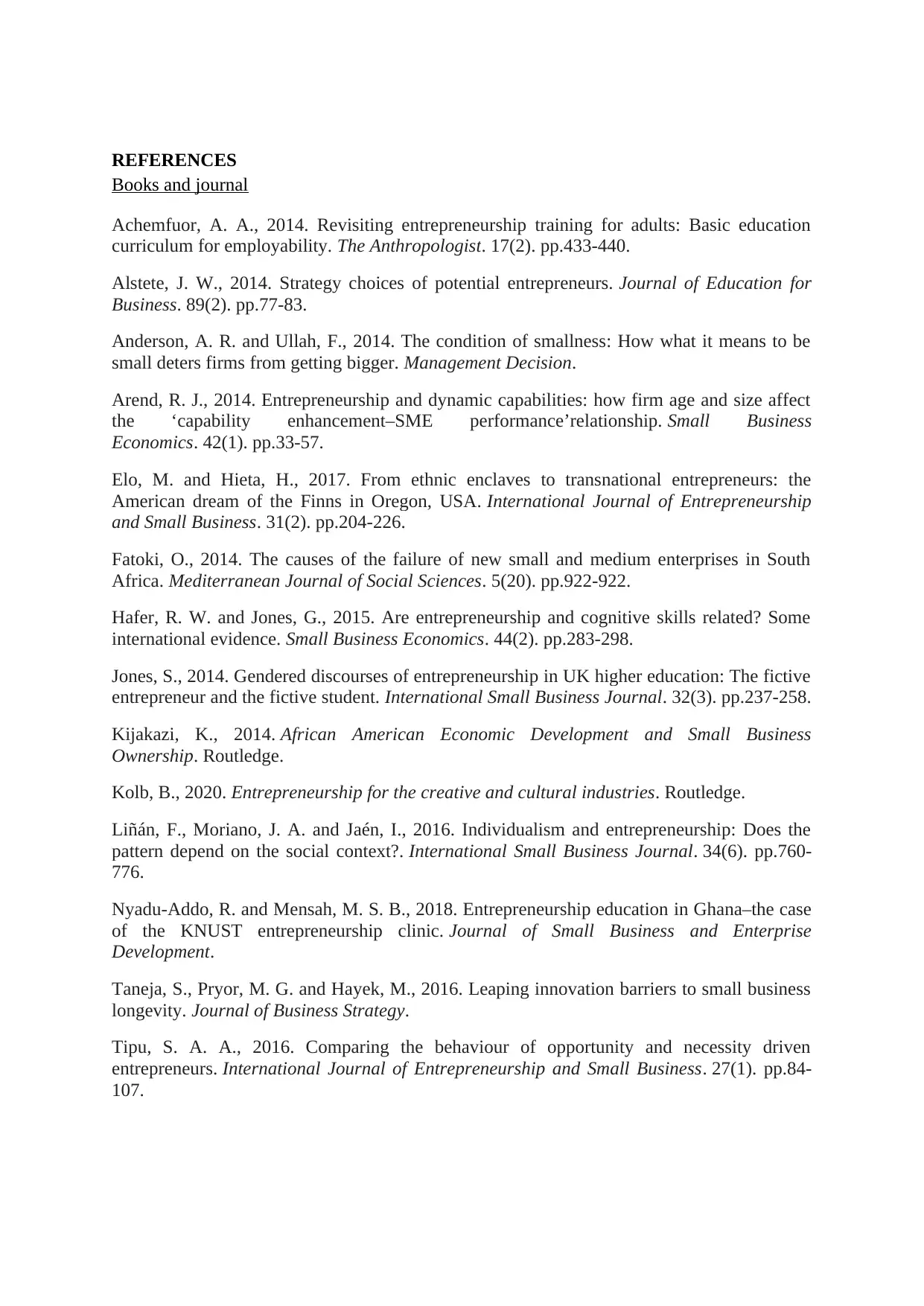
REFERENCES
Books and journal
Achemfuor, A. A., 2014. Revisiting entrepreneurship training for adults: Basic education
curriculum for employability. The Anthropologist. 17(2). pp.433-440.
Alstete, J. W., 2014. Strategy choices of potential entrepreneurs. Journal of Education for
Business. 89(2). pp.77-83.
Anderson, A. R. and Ullah, F., 2014. The condition of smallness: How what it means to be
small deters firms from getting bigger. Management Decision.
Arend, R. J., 2014. Entrepreneurship and dynamic capabilities: how firm age and size affect
the ‘capability enhancement–SME performance’relationship. Small Business
Economics. 42(1). pp.33-57.
Elo, M. and Hieta, H., 2017. From ethnic enclaves to transnational entrepreneurs: the
American dream of the Finns in Oregon, USA. International Journal of Entrepreneurship
and Small Business. 31(2). pp.204-226.
Fatoki, O., 2014. The causes of the failure of new small and medium enterprises in South
Africa. Mediterranean Journal of Social Sciences. 5(20). pp.922-922.
Hafer, R. W. and Jones, G., 2015. Are entrepreneurship and cognitive skills related? Some
international evidence. Small Business Economics. 44(2). pp.283-298.
Jones, S., 2014. Gendered discourses of entrepreneurship in UK higher education: The fictive
entrepreneur and the fictive student. International Small Business Journal. 32(3). pp.237-258.
Kijakazi, K., 2014. African American Economic Development and Small Business
Ownership. Routledge.
Kolb, B., 2020. Entrepreneurship for the creative and cultural industries. Routledge.
Liñán, F., Moriano, J. A. and Jaén, I., 2016. Individualism and entrepreneurship: Does the
pattern depend on the social context?. International Small Business Journal. 34(6). pp.760-
776.
Nyadu-Addo, R. and Mensah, M. S. B., 2018. Entrepreneurship education in Ghana–the case
of the KNUST entrepreneurship clinic. Journal of Small Business and Enterprise
Development.
Taneja, S., Pryor, M. G. and Hayek, M., 2016. Leaping innovation barriers to small business
longevity. Journal of Business Strategy.
Tipu, S. A. A., 2016. Comparing the behaviour of opportunity and necessity driven
entrepreneurs. International Journal of Entrepreneurship and Small Business. 27(1). pp.84-
107.
Books and journal
Achemfuor, A. A., 2014. Revisiting entrepreneurship training for adults: Basic education
curriculum for employability. The Anthropologist. 17(2). pp.433-440.
Alstete, J. W., 2014. Strategy choices of potential entrepreneurs. Journal of Education for
Business. 89(2). pp.77-83.
Anderson, A. R. and Ullah, F., 2014. The condition of smallness: How what it means to be
small deters firms from getting bigger. Management Decision.
Arend, R. J., 2014. Entrepreneurship and dynamic capabilities: how firm age and size affect
the ‘capability enhancement–SME performance’relationship. Small Business
Economics. 42(1). pp.33-57.
Elo, M. and Hieta, H., 2017. From ethnic enclaves to transnational entrepreneurs: the
American dream of the Finns in Oregon, USA. International Journal of Entrepreneurship
and Small Business. 31(2). pp.204-226.
Fatoki, O., 2014. The causes of the failure of new small and medium enterprises in South
Africa. Mediterranean Journal of Social Sciences. 5(20). pp.922-922.
Hafer, R. W. and Jones, G., 2015. Are entrepreneurship and cognitive skills related? Some
international evidence. Small Business Economics. 44(2). pp.283-298.
Jones, S., 2014. Gendered discourses of entrepreneurship in UK higher education: The fictive
entrepreneur and the fictive student. International Small Business Journal. 32(3). pp.237-258.
Kijakazi, K., 2014. African American Economic Development and Small Business
Ownership. Routledge.
Kolb, B., 2020. Entrepreneurship for the creative and cultural industries. Routledge.
Liñán, F., Moriano, J. A. and Jaén, I., 2016. Individualism and entrepreneurship: Does the
pattern depend on the social context?. International Small Business Journal. 34(6). pp.760-
776.
Nyadu-Addo, R. and Mensah, M. S. B., 2018. Entrepreneurship education in Ghana–the case
of the KNUST entrepreneurship clinic. Journal of Small Business and Enterprise
Development.
Taneja, S., Pryor, M. G. and Hayek, M., 2016. Leaping innovation barriers to small business
longevity. Journal of Business Strategy.
Tipu, S. A. A., 2016. Comparing the behaviour of opportunity and necessity driven
entrepreneurs. International Journal of Entrepreneurship and Small Business. 27(1). pp.84-
107.
1 out of 13
Related Documents
Your All-in-One AI-Powered Toolkit for Academic Success.
+13062052269
info@desklib.com
Available 24*7 on WhatsApp / Email
![[object Object]](/_next/static/media/star-bottom.7253800d.svg)
Unlock your academic potential
© 2024 | Zucol Services PVT LTD | All rights reserved.





